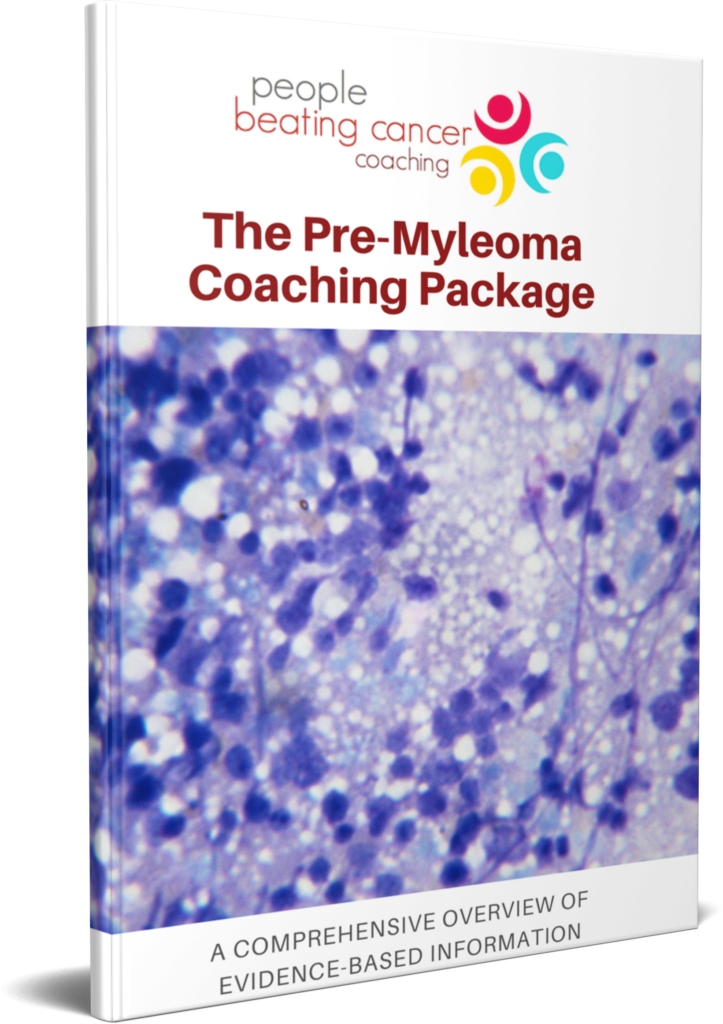
Diagnosed with SMM, SPB, or MGUS?
Learn how you can stall the development of full-blown Multiple Myeloma with evidence-based nutritional and supplementation therapies.
Click the orange button to the right to learn more.
- You are here:
- Home »
- Blog »
- Pre-Myeloma »
- Smoldering Myeloma- When to Treat?
Smoldering Myeloma- When to Treat?

“The optimal endpoint for studies evaluating progression from SMM to active MM is OS or a substantial improvement in the quality of life.”
For as long as I can remember, conventional oncology considered pre-multiple myeloma to NOT be cancer. That is to say, MGUS and SMM, the two diagnostic stages preceding multiple myeloma, are not cancer.
Conventional oncology considers the diagnostic stages of MGUS and SMM to be “blood disorders.” Newly diagnosed MGUS or SMM patients would be told that there was nothing to be done, no available therapies for their blood disorders.
Some newly diagnosed pre-MM patients were even told that they had to “wait for the other shoe to drop.” Oncologists have never been known for their bedside manner.
Dozens of newly diagnosed MGUS/SMM patients would reach out to me and explain that they were not comfortable “watching and waiting.” That there must be something they could do to reduce their risk of a full-blown multiple myeloma diagnosis.
In fact, there is something pre-MM patients can do to reduce their risk of MM. Many things actually.
According to research, we all have a risk of a MM diagnosis. But this risk is tiny. MM is a rare cancer resulting in less than 2% of all cancer diagnoses in the United States annually.
- But once a person is diagnosed with MGUS this tiny risk of MM will increase by about 1% annually. MGUS patients have a 1% annual risk of a MM diagnosis.
- SMM patients have about a 10% risk of a MM diagnosis annually. And this increased risk of MM jumps around for the first 10 years.
The newly diagnosed SMM patient will have a difficult time trying to figure out When To Treat his/her SMM in hopes of avoiding a diagnosis of MM. When I use the word treat in this case, I’m talking about conventional, toxic chemotherapy.
The article linked and excerpted below analyzes the results of several clinical trials designed to evaluate if treatment of smoldering multiple myeloma enhances either length of life (OS) or quality of life (QOL).
To summarize the results of the analysis discussed below:
- Most if not all SMM patients respond to therapy-
- The progression of SMM to MM can be slowed-
- Those SMM patients who undergo therapy experience short, long-term and late stage side effects-
- At this time, there is no significant OS difference observed between treatment and no treatment groups of SMM patients.
I encourage you to read the study linked below. There is lots of important info. I will continue to research the issue of active treatment of SMM patients and if this active treatment either/or improves length of life and/or quality of life.
Let me be clear. According to research, if SMM patients undergo chemotherapy or other types of conventional treatment in hopes of holding off MM, they will respond and they will reduce their risk of MM/slow their diagnosis of MM. Unfortunately, these patients will also experience side effects reducing their quality of life and will not increase their OS aka will not live longer than patients who do not undergo chemotherapy.
To Learn More about a Pre-Myeloma Diagnosis- click now
Have you been diagnosed with either MGUS or SMM? If you would like to learn about evidence-based, non-toxic therapies shown to reduce the risk of a full-blown MM diagnosis, scroll down the page and send me an email. I will get back to you ASAP.
Thanks,
David Emerson
- MM Survivor
- MM Cancer Coach
- Director PeopleBeatingCancer
Recommended Reading:
- Smoldering Multiple Myeloma Diagnosis 4,14 Translocation-
- Myeloma Survival- Low-dose Maintenance Therapy
- Multiple Myeloma- Newly Diagnosed Without Intent to ASCT
- Nutrition, Supplementation as Multiple Myeloma Therapy
Treatment of Smoldering Multiple Myeloma: Ready for Prime Time?
“We discuss evidence supporting early intervention for SMM—both as a preventative strategy to delay progression and as an intensive treatment strategy with a goal of potential cure. We highlight ongoing trials and focus on better defining who may require early intervention…”
4.1. Prevention
Recently, the Eastern Cooperative Oncology Group revisited lenalidomide in SMM in a larger randomized study, E3A06. This study evaluated 182 patients with SMM and randomized patients to lenalidomide, as a single agent without dexamethasone (n = 90) vs. observation (n = 92) [44]. Eligible patients had SMM with bone marrow plasma cells ≥10% and an abnormal sFLC ratio.
In the treatment arm, lenalidomide was given according to the conventional schedule, 25 mg daily for three weeks in a 4-week cycle. The primary endpoint was progression-free survival (PFS). To meet the requirement of disease progression, both biochemical disease progression and development of end-organ damage had to be present. Although the study began prior to the 2014 IMWG revised definition of SMM, most patients had no myeloma-defining events, thus meeting the current criteria. Unlike previous studies, the evaluation for bone involvement utilized more sensitive modern imaging, requiring MRI of the spine and pelvis at the time of study entry.
The overall response in the treatment arm was 50%, and as expected, no responses were reported in the observation arm. Early intervention with lenalidomide improved PFS vs. observation alone (HR 0.28; 95% CI 0.12–0.62).
The PFS at one, two, and three years in patients receiving lenalidomide was 98%, 93%, and 91%. In the observation arm, the corresponding PFS was 89%, 76%, and 66%. The improved PFS was most pronounced in the high-risk category defined in the 2018 Mayo 20/2/20 model (n = 56; HR 0.09; 95% CI 0.02–0.44).
Despite undergoing spine and pelvis MRI at screening, the most common cause of progression in the observation arm was bone-related progression (52.4%; 11 of 21 progressive disease cases). It would be important to know if these progressions were associated with symptoms, which is more clinically relevant, and how they were detected…
At this time, there is no significant OS difference observed between the arms.
Thirty-six patients (41%) experienced grade 3–4 hematologic or nonhematologic adverse events in the lenalidomide arm, of which 25 patients (28%) had grade 3–4 nonhematological adverse events. The most common grade 3-4 adverse events were neutropenia (13.6%) and infection (10.2%). Details of the adverse events in the observation arm were not reported.
The cumulative incidence of invasive second primary cancers at 3 years was 5.2% vs. 3.5% in the lenalidomide vs. observation arm, respectively. Eighteen (20%) of the lenalidomide-treated patients had treatment discontinuation and 80% of patients had a reduced dose…
Since patients with SMM do not have any symptoms (by definition), there is a greater premium placed on the tolerability of the intervention as well as demonstration of a benefit with the overall survival rather than only PFS. Despite a comparable quality of life between the groups, a significant portion of patients reported adverse drug events requiring therapy discontinuation or dose reduction…
4.2. Treatment and Other Ongoing Studies
On the other end of the spectrum is a more aggressive approach aimed at achieving a negative minimal residual disease (MRD) state with the hope of cure [5].
The hypothesis behind this approach is that SMM is where the best opportunity exists for a potential cure by inducing a deep response while the mutational burden is low and disease potentially more responsive to treatment [46]. Several early phase I/II trials investigating intensive regimens in SMM have reported their results. Table 4 shows the results of clinical trials investigating early intervention as a treatment strategy in SMM. In the phase II study investigating the use of carfilzomib, lenalidomide, and dexamethasone (KRd) in patients newly diagnosed with MM (NDMM) and high-risk SMM, patients received eight cycles of KRd induction, followed by lenalidomide maintenance for 2 years [47].
All 12 patients in the high-risk SMM cohort met the definition of high-risk disease based on the PETHEMA risk stratification model, and one patient also met the definition based on the Mayo risk stratification model. Skeletal survey and FDG-PET/CT were used to rule out osteolytic lesions.
After a median follow-up of 15.9 months, 100% of the high-risk SMM patients achieved CR, 92% MRD negativity by multiparametric flow cytometry (95% CI 43–94%), and 75% MRD negativity by next-generation sequencing (95% CI 43–94%). Grade 3–4 adverse events were reported to be lymphopenia (50%), neutropenia (17%), rash (33%), infection (8%), and cardiac adverse events (8%).
Of note, KRd in the NDMM cohort resulted in a lower CR rate of 56%, suggesting that the treatment may have induced a deeper response in high-risk SMM patients who may be more treatment sensitive…
The role of engaging immune checkpoints in MM in combinations with immunomodulatory drugs like lenalidomide [54] or pomalidomide [55] is, however, on hold at the current time given unexpected worse outcomes but is being evaluated in other combinations.
Another study aimed at engaging the immune response to prevent progression is a phase I/IIa study of a PVX-410 multipeptide vaccine with or without lenalidomide in 22 patients with intermediate- or high-risk SMM [56]. Twelve patients received 6 doses of PVX-410 vaccine alone (3 in low-dose, 9 in target-dose cohort) and 10 patients received 3 cycles of lenalidomide in addition to the vaccine.
The immune response to PVX-410 was achieved in 95% (N = 20 evaluable patients; 10/11 patients (PVX-410 monotherapy); 9/9 patients (PVX-410 + R combination)). Most common adverse events were local injection site reactions and constitutional symptoms. These results provided a basis for further evaluation in a larger study…
5.1. Who Requires Early Intervention?
In the modern era of novel drugs, more sensitive disease detection, and ongoing improvements in risk stratification, the question of who benefits the most from early intervention is still very relevant. As definitions and diagnostic criteria continue to evolve, our ability to accurately identify those with truly high-risk SMM with imminent progression to active disease will improve. Given the significant heterogeneous clinical course of SMM, current risk stratification models do not always reliably identify patients who will progress despite being classified as high risk…
It may be prudent to continue close observation as a standard approach.
The optimal endpoint for studies evaluating progression from SMM to active MM is OS or a substantial improvement in the quality of life.
Many recent studies investigating early intervention in SMM incorporated high-risk cytogenetic features, as well as standard classification from risk stratification models. Results from these studies and mature data on OS from recent studies will provide further guidance in the broad incorporation of early intervention as standard practice in high-risk SMM in order to prevent or delay progression. Until more data are available, these patients should be followed very closely for evidence of progression…
7. Conclusions
Evidence supporting early intervention is emerging, but without any demonstration of an improvement in the overall survival, patients with high-risk SMM are best managed in the clinical trials setting until we have more data.


